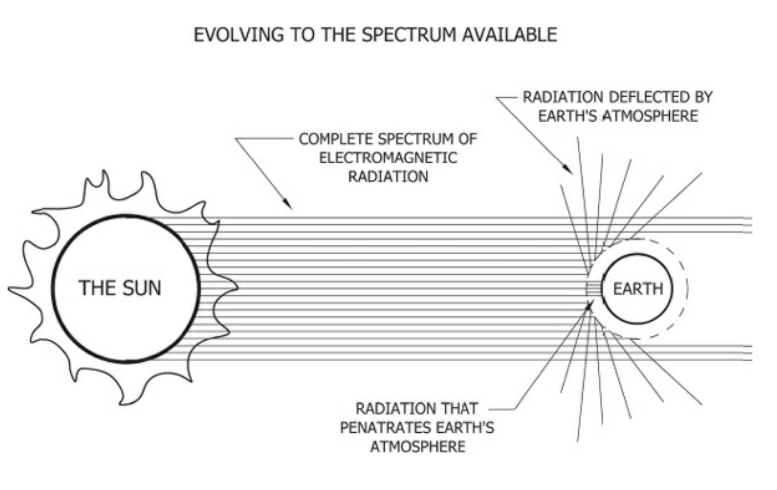23. Why sunlight looks good
One thing I’ve taken away from reading my interior lighting design textbook: even light that is the same color and same warmth can have a different feel. The physics can explain why an LED light bulb — even if adjusted to a “warm” glow — feels much worse than sunlight.
The short answer is that the lightbulb has a lower illuminance. I think it’s worth it to take a step back to understand what this means and why it’s important.
The sun emits waves along the entire electromagnetic spectrum. These waves are generated by nuclear fusion. Despite the sun emitting light across the entire electromagnetic spectrum, our atmosphere blocks most of the waves and so there are only a few that actually make it through to us. The three types of waves that make it through are ultra-violet light, visible light, and infra-red light (along with some smaller amounts of some of the other kinds of radiation).

The visible light is the one we want to focus on. Visible light is represented by wavelengths that are between 380 nanometers and 780 nanometers. (To put it in perspective, a human hair is between 80k-100k nm).

Within the visible light, each specific wavelength represents a different color perceived by humans. There’s actually no objective “color” out in the world. There’s radiation traveling through the world at a wavelength of 380 nm, and that’s objectively true. But the fact that humans almost universally perceive that as the color “violet” is just how we’ve evolved to experience that phenomenon.
When we look directly at sunlight (don’t do this), it’s just really bright and strong. I’m less concerned about this. But recall from a previous post that what we perceive as light comes from surfaces. Light doesn’t come from the air or atmosphere. When we look at sunlit-surfaces, they are warm and full. We are drawn to them. We tend to like them even more than similarly-colored surfaces that are lit by other light sources.
You may remember from a high school biology class that our eyes have rods and cones. These rods and cones are how we translate light and color (waves) into things that are sensible to our brain. Cones are the most interesting for this discussion: they are responsible for our color vision (and they are very small so they detect detail).
Cones are interesting because there are there are only three types (or “classes”) of cones. They are named for the color that they perceive: R (red), G (green), and B (blue). They perceive different kinds of colors based on their peak sensitivity in the spectrum.

For any given wavelength, you can think of each type of cone casting a vote of intensity depending on which wavelength coming in.
For example, if your eyes were receiving radiation, and that radiation only had a wavelength of say 760 nm, you’d perceive it as red. Importantly, it would also be almost all perceived by the R cone and not the B or G ones.

Another example (from the book): if you perceived radiation with a wavelength of 520 nm, it would be mostly perceived by G cones, a little bit from B, and not at all from R.

A more likely scenario is that a light source emits multiple waves of radiation at once (not just one). When this happens, the cones take the average of the waves coming in, and once again “send back” a single value back to the brain. Look at the B in the following figure. There’s one that’s at 9, one at 1, and one at 3 or so. We don’t know the exact values, but the B cones have determined that the average is 6, so it returns a 6.

In this way, any wave or combination of waves can be boiled down in our brain to the three values perceived by each one of our cone classes.
Where this gets interesting is how the brain perceives “neutral” or white light. This occurs when all of the cones return back the same number. Most of the time (like from sunlight) the perception of neutral light occurs because of lots of waves coming at the same time. In these circumstances, the cones send the same numbers to the brain (oftentimes all very high numbers) and the brain perceives a neutral light as there isn’t one wave that stands out.

But modern technology has enabled us to “trick” the brain by sending a minimum amount of waves in order to get the cones to return the same number. When they return the same number, we perceive neutrality. For example, if we create a light source that emits just two wavelengths — one that’s a blue light and one that’s an orange — we perceive neutral light even though it has very poor and shallow color rendering.

When we perceive a neutral light, we are tempted to believe that the light source will accurately render all of the colors. But in fact, it’s just rendering a small amount (two in this case). The rest would be muddled and grey.
Luckily, we can measure the wavelengths emitted from a light source. And we’ve developed a system to quantify the completeness of the spectral output. We call it “color rendering index”, or CRI. It’s described on a scale from 0-100.
Sunlight, naturally, has a color rendering index of ~100. Some light bulbs, like incandescent, have CRIs in the high 90s. This is very good. Other light bulbs, like bad LED’s, have CRIs in the 70s. These have an incomplete color completeness, and are instead creating a neutral light with a smaller number of waves.

This is basically why sunlight look good. When you view something illuminated with sunlight, you are literally looking at more colors than something illuminated with light from a poor LED bulb.